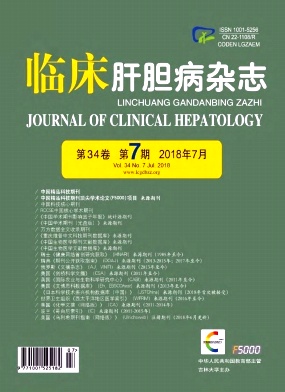|
[1]JIN Y, WANG X, ZHANG LJ, et al.Risk factors for early rebleeding after esophageal variceal ligation in patients with liver cirrhosis[J].J Clin Hepatol, 2017, 33 (11) :2147-2151. (in Chinese) 金燕, 王雪, 张玲娟, 等.肝硬化患者食管静脉曲张套扎术后早期再出血的危险因素分析[J].临床肝胆病杂志, 2017, 33 (11) :2147-2151.
|
|
[2]MAO P, XIANG YL.Cause of early and late rebleeding after endoscopic variceal ligation and the nursing[J].China J Endosc, 2013, 19 (7) :732-735. (in Chinese) 毛平, 向亚利.内镜下套扎治疗食管静脉曲张术后早、晚期再出血的原因分析及处理[J].中国内镜杂志, 2013, 19 (7) :732-735.
|
|
[3] Esophageal and Gastric Varices Group, Chinese Society of Endoscopy, Chinese Medical Association.Tentative guidelines for endoscopic diagnosis and treatment of varicosity and variceal bleeding in digestive tract (2009) [J].Chin J Dig Endosc, 2010, 27 (1) :1-4. (in Chinese) 中华医学会消化内镜学分会食管胃静脉曲张学组.消化道静脉曲张及出血的内镜诊断和治疗规范试行方案 (2009年) [J].中华消化内镜杂志, 2010, 27 (1) :1-4.
|
|
[4]LU ZY, ZHONG NS.Internal Medicine[M].7th ed.Beijing:People's Medical Publishing House, 2008:453. (in Chinese) 陆再英, 钟南山.内科学[M].第7版.北京:人民卫生出版社, 2008:453.
|
|
[5]de FRANCHIS R, Baveno VI Faculty.Expanding consensus in portal hypertension:Report of the Baveno VI Consensus Workshop:Stratifying risk and individualizing care for portal hypertension[J].J Hepatol, 2015, 63 (3) :743-752.
|
|
[6]HERRERA JL.Management of acute variceal bleeding[J].Clin Liver Dis, 2014, 18 (2) :347-357.
|
|
[7]YANG ZF, ZHAO Q, WANG XY, et al.Portal venous flow before and after esophageal variceal ligation[J].Chin J Dig Endosc, 2004, 21 (3) :184-185. (in Chinese) 杨占凤, 赵群, 王晓燕, 等.食管静脉曲张套扎术前后门静脉血流的研究[J].中华消化内镜杂志, 2004, 21 (3) :184-185.
|
|
[8]SHEVCHENKO IUL, OBUKHOVSKIIBI, IAKOVENKO AV.The clinical course of portal hypertensive gastropathy after ligation of esophageal varicose veins[J].Klin Med (Mosk) , 2007, 85 (5) :47-51.
|
|
[9]VUACHET D, CERVONI JP, VUITTON L, et al.Improved survival of cirrhotic patients with variceal bleeding over the decade 2000-2010[J].Clin Res Hepatol Gastroenterol, 2015, 39 (1) :59-67.
|
|
[10]ZHOU JN, WEI Z, SUN ZQ.Risk factors for early rebleeding after esophageal variceal ligation in patients with liver cirrhosis[J].Chin J Hepatol, 2016, 24 (7) :486-492. (in Chinese) 周嘉宁, 魏志, 孙自勤.肝硬化食管静脉曲张套扎后早期再出血相关危险因素的多中心研究[J].中华肝脏病杂志, 2016, 24 (7) :486-492.
|
|
[11]WANG Z, LUO XF, LI X.Risk factors for early rebleeding after elective endoscopic variceal ligation (EVL) and long-term outcome:A retrospective analysis[J].Chin J Dig Endosc, 2013, 30 (12) :668-670. (in Chinese) 王竹, 罗薛峰, 李肖.食管静脉曲张择期内镜下套扎术后早期再出血及远期预后的回顾性分析[J].中华消化内镜杂志, 2013, 30 (12) :668-670.
|
|
[12]PROCOPETB, TANTAU M, BUREAU C.Are there any alternative methods to hepatic venous pressure gradient in portal hypertension assessment?[J].J Gastrointestin Liver Dis, 2013, 22 (1) :73-78.
|
|
[13]XU L, JI F, XU QW, et al.Risk factors for predicting early variceal rebleeding after endoscopic variceal ligation[J].World J Gastroenterol, 2011, 17 (28) :3347-3352.
|
|
[14]GROTHAUS J, PETRASCH F, ZEYNALOVA S, et al.Risk factors for bleeding complications after endoscopic variceal ligation therapy[J].Z Gastroenterol, 2010, 48 (10) :1200-1206.
|
|
[15]PENG Y, QI XS, GUO XZ.Recommendations for consensus statement by the Italian Association for the Study of Liver Diseases (AISF) and the Italian Society of Internal Medicine (SIMI) :Hemostatic balance in patients with liver cirrhosis[J].J Clin Hepatol, 2016, 32 (6) :1052-1053. (in Chinese) 彭颖, 祁兴顺, 郭晓钟.《2016年意大利肝病学会和意大利医学学会共识:肝硬化止血平衡》推荐意见[J].临床肝胆病杂志, 2016, 32 (6) :1052-1053.
|
|
[16]LATA J, HUSOVAL, JURANKOVAJ, et al.Factors participating in the development and mortality of variceal bleeding in portal hypertension-possible effects of the kidney damage and malnutrition[J].Hepatogastroenterology, 2006, 53 (69) :420-425.
|
|
[17]DELL'ERA A, IANNUZZI F, FABRIS FM, et al.Impact of portal vein thrombosis on the efficacy of endoscopic variceal band ligation[J].Dig Liver Dis, 2014, 46 (2) :152-156.
|
|
[18]SENZOLO M, M SARTORI T, ROSSETTO V, et al.Prospective evaluation of anticoagulation and transjugular intrahepatic portosystemic shunt for the management of portal vein thrombosis in cirrhosis[J].Liver Int, 2012, 32 (6) :919-927.
|
|
[19]LIU B, FANG ZY, MENG DM.Progress of prevention and treatment of complications of liver cirrhosis[J].J Chin Pract Diagn Ther, 2016, 30 (12) :1152-1155. (in Chinese) 刘斌, 方正亚, 孟冬梅.肝硬化并发症治疗及预防研究进展[J].中华实用诊断与治疗杂志, 2016, 30 (12) :1152-1155.
|







 DownLoad:
DownLoad: